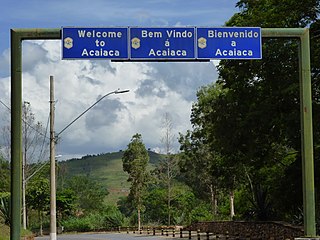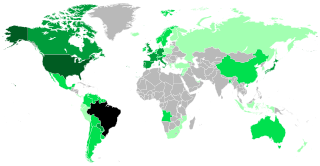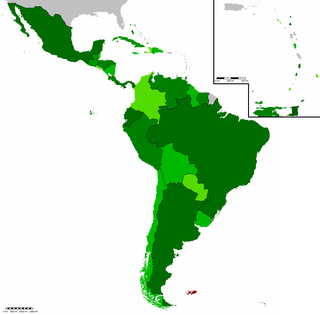Related Research Articles

Brazil, officially the Federative Republic of Brazil, is the largest country in South America and in Latin America. Brazil is the world's fifth-largest country by area and the seventh most populous. Its capital is Brasília, and its most populous city is São Paulo. The federation is composed of the union of the 26 states and the Federal District. It is the only country in the Americas to have Portuguese as an official language. It is one of the most multicultural and ethnically diverse nations, due to over a century of mass immigration from around the world, and the most populous Roman Catholic-majority country.

Latin America are the countries and regions of the Americas where Romance languages—languages derived from Latin —are predominantly spoken. The term was coined in France in the mid-19th century to refer to regions in the Americas that were ruled by the Spanish, Portuguese, and French empires. The term does not have a precise definition, but it is "commonly used to describe South America, Central America, Mexico, and the islands of the Caribbean." In a narrow sense, it refers to Spanish America and Brazil. The term "Latin America" is broader than Hispanic America, which specifically refers to Spanish-speaking countries; and lesser than categories such as Ibero-America, a term that refers to both Spanish and Portuguese-speaking countries from Europe and Americas.

Rio de Janeiro, or simply Rio, is the capital of the state of Rio de Janeiro, and the second-most-populous city in Brazil, after São Paulo. Listed by the GaWC as a beta global city, Rio de Janeiro is the sixth most populous city in the Americas. Part of the city has been designated as a World Heritage Site, named "Rio de Janeiro: Carioca Landscapes between the Mountain and the Sea", on 1 July 2012 as a Cultural Landscape.

The German diaspora consists of German people and their descendants who live outside of Germany. The term is used in particular to refer to the aspects of migration of German speakers from Central Europe to different countries around the world. This definition describes the "German" term as a sociolinguistic group as opposed to the national one since the emigrant groups came from different regions with diverse cultural practices and different varieties of German. For instance, the Alsatians and Hessians were often simply called "Germans" once they set foot in their new homelands.

The Community of Portuguese Language Countries, also known as the Lusophone Community, is an international organization and political association of Lusophone nations across four continents, where Portuguese is an official language. The CPLP operates as a privileged, multilateral forum for the mutual cooperation of the governments, economies, non-governmental organizations, and peoples of the Lusofonia. The CPLP consists of 9 member states and 33 associate observers, located in Europe, South America, Asia, Africa and Oceania, totaling 38 countries and 4 organizations.

São Paulo is the most populous city in Brazil and the capital of the state of São Paulo. Listed by the GaWC as an alpha global city, São Paulo is the most populous city outside of Asia and the world's 4th largest city proper by population. Additionally, São Paulo is the largest Portuguese-speaking city in the world. It exerts strong international influences in commerce, finance, arts and entertainment. The city's name honors the Apostle, Saint Paul of Tarsus. The city's metropolitan area, the Greater São Paulo, ranks as the most populous in Brazil and the 12th most populous on Earth. The process of conurbation between the metropolitan areas around the Greater São Paulo created the São Paulo Macrometropolis, a megalopolis with more than 30 million inhabitants, one of the most populous urban agglomerations in the world.

Japanese Brazilians are Brazilian citizens who are nationals or naturals of Japanese ancestry or Japanese immigrants living in Brazil or Japanese people of Brazilian ancestry.

The Portuguese people are a Romance-speaking ethnic group and nation indigenous to Portugal, a country in the west of the Iberian Peninsula in the south-west of Europe, who share a common culture, ancestry and language.

German Brazilians refers to Brazilians of full or partial German ancestry. German Brazilians live mostly in the country's South Region, with a smaller but still significant percentage living in Southeast Region.

Arab diaspora is a term that refers to descendants of the Arab emigrants who, voluntarily or as forcibly, migrated from their native lands to non-Arab countries, primarily in the Americas, Europe, Southeast Asia, and West Africa.
This article details the geographical distribution of speakers of the German language, regardless of the legislative status within the countries where it is spoken. In addition to the German-speaking area in Europe, German-speaking minorities are present in many countries and on all six inhabited continents.
Latin Americans are the citizens of Latin American countries.
Brazilian Americans are Americans who are of full or partial Brazilian ancestry. The Brazilian Ministry of Foreign Affairs estimates the Brazilian American population to be 1,905,000, the largest of any Brazilian diaspora. The largest wave of Brazilian migration to the United States occurred in the late 1980s and early 1990s as a response to hyperinflation in Brazil. Even after inflation stabilized in 1994, Brazilian immigration continued as Brazilians left in search of higher wages in the United States.

The Brazilian diaspora is the migration of Brazilians to other countries, a mostly recent phenomenon that has been driven mainly by economic recession and hyperinflation that afflicted Brazil in the 1980s and early 1990s, and since 2014, by the political and economic crisis that culminated in the impeachment of Dilma Rousseff in 2016 and the election of Jair Bolsonaro in 2018, in addition to chronic violence in Brazilian urban centers.

Portuguese is the official and national language of Brazil being widely spoken by most of the population. Brazil is the most populous Portuguese-speaking country in the world, with its lands comprising the majority of Portugal’s former colonial holdings in the Americas.

White Brazilians refers to Brazilian citizens who are considered or self-identify as "white", typically because of European or Levantine descent.

Brazilians are the citizens of Brazil. A Brazilian can also be a person born abroad to a Brazilian parent or legal guardian as well as a person who acquired Brazilian citizenship. Brazil is a multiethnic society, which means that it is home to people of many ethnic origins, and there is no correlation between one's stock and their Brazilian identity.

Brazil had an official resident population of 203 million in 2022, according to IBGE. Brazil is the seventh most populous country in the world, and the second most populous in the Americas and Western Hemisphere.

Brazil–Mexico relations are the diplomatic and bilateral relations between the Federative Republic of Brazil and the United Mexican States. Together, Brazil and Mexico account as the most populous nations in Latin America and both nations have the largest global emerging economies and are considered to be regional powers. Both countries are members of the Community of Latin American and Caribbean States, G-20 major economies, Latin American Integration Association, Organization of American States, Organization of Ibero-American States and the United Nations.

The Community of Latin American and Caribbean States (CELAC) is a regional bloc of Latin American and Caribbean states proposed on February 23, 2010, at the Rio Group–Caribbean Community Unity Summit, and created on December 3, 2011, in Caracas, Venezuela, with the signature of The Declaration of Caracas. It consists of 33 countries in Latin America and the Caribbean having five official languages.
References
- ↑ ComunidadeBrasileira2020.pdf (PDF) (Report).
- ↑ "Estadísticas Históricas de México" (PDF). National Institute of Statistics and Geography. pp. 83, 86. Archived from the original (PDF) on 1 February 2016. Retrieved 30 September 2015.
- ↑ Wollny, Hans (January 1990). "México y el reto del asilo: una visión desde afuera" (PDF). Boletín Mexicano de Derecho Comparado. UNAM. 1 (69). Archived (PDF) from the original on 2 March 2016. Retrieved 19 February 2016.
- 1 2 3 Ventura, Abida (10 June 2016). "Un pedazo de Brasil en México". El Universal. Archived from the original on 27 October 2016. Retrieved 26 October 2016.
